The neck of king Oto Uta was
brought to Easter Island by king Hotu's pair of
guardian spirits (atua
akuaku) viz. Kuihi and Kuaha:
Ihi. 1. Line of singing women at a feast
or an êi. 2. Ihi, ihi-ihi,
to break up into small pieces, to crumble, to
tear to pieces; he-ihi i te maúku, to
separate fibres. Vanaga. Ihiihi, to hop.
Churchill.
Aha.What? Which? To do, to be what? He
aha koe? what are you? E-aha-á koe?
what are you doing? Ku-aha-á koe? what
have you done? Kahu aha? what, which
garment? E-aha-mai-á ki a koe? what does
that do you, what harm does it do you, what is
it to you? Aha is preceded by the article
te when introduced by a preposition te:
o te aha, why, what for; mo te aha, ki te
aha, what for, with what purpose? Vanaga.
Gaaha, to burst, to become ruptured, to have
a discharge of pus, of blood. Ku gaaha te
toto o te ihu. He had a nose-bleed. E û'i
koe o gaaha te îpu. Be careful not to break
the bottle (lit. look out lest the bottle
burst). E tiaki á au mo gaaha mai o te
harakea. I shall wait for the abcess to
burst. Gaatu, totora reed. Vanaga. To
break, to split, to crack, to rive; fracture,
fissure, break, crack, crevice (gaaha);
niho gaa, toothache, broken teeth;
gaamiro (miro, ship) shipwreck;
gaàpu (pu 2), abortion; poki gaàpu,
abortive child. T Mq.: naha, nafa,
split, fissure. Ta.: aha, afa,
crack fissure. Gaatu 1. Bulrush, reed. 2.
(gatu). Churchill.
|
he
ki a Hotu.ku kori ana tau ngaio
era i te ariki |
Hotu spoke, 'These fellows have
done a mean thing [ku
kori ana tau ngaio era]
to King Oto Uta!" |
|
i a
oto uta. |
|
i
hati era te
ngao.o
te ariki o oto uta.he ōho.atu |
After the neck of Oto Uta had
been broken, Kuihi and Kuaha
arrived. They picked up the neck
of King Oto Uta, took it, and
brought it with them. |
|
a
kuihi.a kuaha.he too mai i te
ngao.o te a(-) |
|
riki o oto uta.he mau he ōho.mai
he tuu ki |
|
Gao. 1. Neck. 2. Glans
penis (te gao o te kohio),
neck of penis. Vanaga. Neck,
throat, (naho G); gao
pukupuku, scrofula; hore
te gao, to cut the head off;
arakea gao, scrofula.
Gaogao, calm. Gaoku,
to eat greedily. Gaopu,
to choke on a bone. Churchill. |
|
mua
ki te hanga.ki
hanga rau.i haka
rere ai |
They arrived out in the bay [he
tuu ki mua ki te hanga],
in Hanga Rau. (There) Kuihi and
Kuaha left (the fragment). |
|
e
kuihi.e kuaha. |
The 'neck' was laid to rest
(haka rere) in Hanga Rau
- in the 'Bay of Leaves'.
At the top of the World Tree there surely must
be lots of leaves (as many as the stars in the
canopy) and according to myth this place was
occupied by a little piece of wood which was
used to kill Balder:
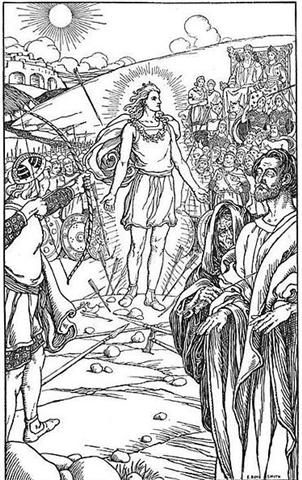
... Hercules first appears in
legend as a pastoral sacred king and, perhaps
because shepherds welcome the birth of twin
lambs, is a twin himself. His characteristics
and history can be deduced from a mass of
legends, folk-customs and megalithic monuments.
He is the rain-maker of his tribe and a sort of
human thunder-storm. Legends connect him with
Libya and the Atlas Mountains; he may well have
originated thereabouts in Palaeolithic times.
The priests of Egyptian Thebes, who called him
Shu, dated his origin as 17,000 years
before the reign of King Amasis.
He carries an oak-club,
because the oak provides his beasts and his
people with mast and because it attracts
lightning more than any other tree. His symbols
are the acorn; the rock-dove, which nests in
oaks as well as in clefts of rocks; the
mistletoe, or Loranthus; and the serpent.
All these are sexual emblems.
The dove was sacred to the Love-goddess of
Greece and Syria; the serpent was the most
ancient of phallic totem-beasts; the cupped
acorn stood for the glans penis in both
Greek and Latin; the mistletoe was an all-heal
and its names viscus (Latin) and ixias
(Greek) are connected with vis and
ischus (strength) - probably because of the
spermal viscosity of its berries, sperm being
the vehicle of life.
This Hercules is male leader of all orgiastic
rites and has twelve archer companions,
including his spear-armed twin, who is his
tanist or deputy. He performs an annual
green-wood marriage with a queen of the woods, a
sort of Maid Marian. He is a mighty hunter and
makes rain, when it is needed, by rattling an
oak-club thunderously in a hollow oak and
stirring a pool with an oak branch -
alternatively, by rattling pebbles inside a
sacred colocinth-gourd or, later, by rolling
black meteoric stones inside a wooden chest -
and so attracting thunderstorms by sympathetic
magic ...
...
To conclude these enquiries
we may say that if Balder was indeed, as I have
conjectured, a personification of a
mistletoe-bearing oak, his death by a blow of
the mistletoe might on the new theory be
explained as a death by a stroke of lightning.
So long as the mistletoe, in
which the flame of the
lightning smouldered, was suffered to remain
among the boughs, so long no harm could befall
the good and kindly god of the oak, who kept his
life stowed away for safety between earth and
heaven in the mysterious parasite; but when once
that seat of his life, or of his death, was torn
from the branch and hurled at the trunk, the
tree fell - the god died - smitten by a
thunderbolt. And what we have said of Balder in
the oak forests of Scandinavia may perhaps, with
all due diffidence in a question so obscure and
uncertain, be applied to the priest of Diana,
the King of the Wood, at Aricia in the oak
forests of Italy. He may have personated in
flesh and blood the great Italian god of the
sky, Jupiter, who had kindly come down from
heaven in the lightning flash to dwell among men
in the mistletoe - the thunder-besom - the
Golden Bough - growing on the sacred oak in the
dells of Nemi. If that was so, we need not
wonder that the priest guarded with drawn sword
the mystic bough which contained the god's life
and his own. The goddess whom he served and
married was herself, if I am right, no other
than the Queen of Heaven, the true wife of the
sky-god. For she, too, loved the solitude of the
woods and the lonely hills, and sailing overhead
on clear nights in the likeness of the silver
moon looked down with pleasure on her own fair
image reflected on the calm, the burnished
surface of the lake, Diana's Mirror ...
At the time of rongorongo the Head of Hercules (Ras
Algethi) rose heliacally in right ascension
day *260 (→ 26000 / 100), when the Full Moon was
at Rigel. *260.8 - *78.1 = *182.7:
|
OCT 1 |
2 |
3 (*196) |
4
(277) |
5 |
6 |
 |
 |
 |
 |
 |
 |
|
Ga7-25 |
Ga7-26 |
Ga7-27 |
Ga7-28 |
Ga7-29 |
Ga7-30 (199) |
|
17h (258.7)
ARRAKIS = μ Draconis
(258.7) |
Mula-19 (The Root)
SABIK
(The Preceding One) =
η
Ophiuchi
(259.7),
η
Scorpii (259.9) |
NODUS I =
ζ
Draconis
(260.0),
π
Herculis (260.7),
RAS ALGETHI
=
α
Herculis
(260.8) |
SARIN =
δ
Herculis
(261.0),
ο
Ophiuchi (261.4)
*220.0 = *261.4 - *41.4
ALRISHA (α Piscium) |
ξ Ophiuchi
(262.2),
θ Ophiuchi, ν Serpentis, ζ, ι
Apodis (262.4), ι Arae (262.8),
ρ Herculis (262.9)
*221.0 = *262.4 - *41.4 |
β, γ Arae (263.3), κ Arae
(263.5), σ Ophiuchi (263.6) |
|
Dec 4 |
5 |
6 (*260) |
7 |
8 (342) |
9 |
|
°Nov 30 |
°Dec 1 (335) |
2 (*256) |
3 |
4 |
5 |
|
'Nov 7 |
8 |
9 |
10 (314) |
11 |
12 (*236) |
|
"Oc 24 |
Tangaroa Uri 25 |
26 |
27 (300) |
28 |
29 (*222) |
|
VIRGO: |
|
14 |
Chitra
the bright one |
α Virginis
Spica |
Bright jewel or
pearl |
Oct 9 (*202) |
|
BOOTES: |
|
15 |
Svāti
very good |
α Bootis
Arcturus |
Shoot of plant,
coral |
Oct 22 (*215) |
|
LIBRA: |
|
16 |
Visakha
forked, having
branches (or the
gift, rādhā) |
α, β, γ and ι Librae
Zuben Elgenubi |
Triumphal arch,
potter's wheel |
Oct 31 (*224) |
|
SCORPIUS:
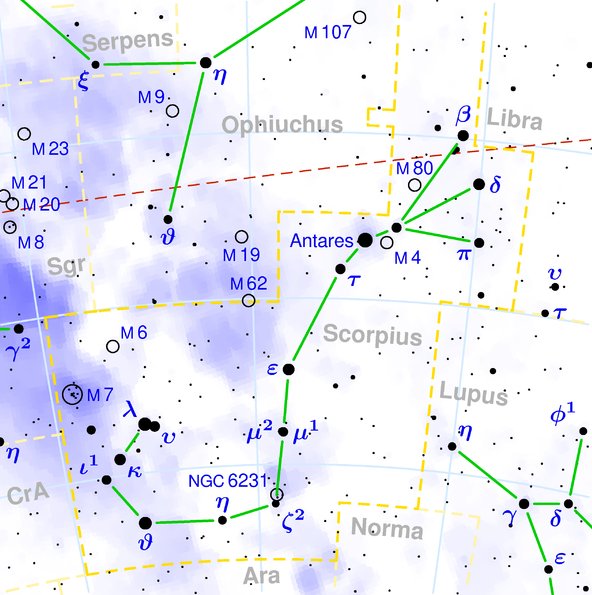
M107 (not listed by
me) is close to ζ
Ophiuchi
- cfr at Ga7-18:

"ζ,
2.8, near the left
knee, was the
Chinese Han,
an old feudal state.
It sometimes shared
with η the title
Sābik, or
Preceding One,
attatched to the
latter star in Al
Tizini's catalogue.
Brown thinks that,
with ε, it marked
the Akkadian lunar
asterism Mulubat,
the Man of Death;
with η the Sogdian
Bastham,
Bound, 'i.e.
Ophiuchus enveloped
in the coils of
Ophis'; and the
Khorasmian
Sardhiwa, the
Head of the Evil
One." (Allen)
Rake,
rakerake: 1.
Bad, ugly, unjust;
to turn nasty (of a
situation); ku
rakerake-á a haho a
te tai, the sea
has turned rough. 2.
To be abundant:
ku rakerake-á te
îka, there are
lots of fish.
Rakerakega,
wickedness. Vanaga.
Bad, in its most
general sense;
patu toona rake,
immodest, to expose
the person
obscenely; rakega,
evil, perversity;
rakerake,
abominable,
frightful, low,
shocking, culpable,
crime, debauchery,
dishonor, fault,
hideous, ignoble,
deformed, illicit,
immodest, immoral,
impious,
irreligious,
lascivious, evil,
bad, obscene,
sinful, ugly;
rakerakega, sin,
cirme, fault,
impiety, iniquity,
evil, vice;
hakarakerake,
causative, to make
bad, etc. Pau.:
marakerake,
afflicted,
disconsolate.
Churchill. ...he
ro korua.e aku hoa
e.ki hahati atu te
ngao o te rakerake
era
(Let's
go my friends (hoa),
let's break the neck
[hahati
atu te ngao]
of this mean one
(or, ugly one,
rakerake). |
|
17 |
Anuradha
following rādhā |
β, δ, and π Scorpii
Vrischika (?) |
Triumphal archway,
lotus |
Nov 17 (*241) |
|
18 |
Jyeshtha
the eldest, most
excellent |
α, σ, and τ Scorpii
Antares (?) |
Circular amulet,
umbrella, earring |
Nov 25 (*249) |
|
19 |
Mula
the root |
ε,
ζ,
η,
θ, ι, κ, λ, and μ
Scorpii
η Scorpii ? |
Bunch of roots tied
together, elephant
goad |
Dec 5 (*259) |
|
|
HAEDUS II = η Aurigae
(75.9) |
5h (76.1)
ε
Leporis (76.0),
CURSA
=
β
Eridani
(76.4),
λ
Eridani (76.7) |
μ Aurigae, μ Leporis (77.6)
|
ĸ Leporis (78.0),
RIGEL
(Foot) =
β
Orionis
(78.1),
Flaming Star = IC405
(78.2),
CAPELLA
(Little Goat) =
α
Aurigae
(78.4),
ο
Columbae,
τ
Orionis (78.8)
*37.0 = *78.4 - *41.4
THUBAN (α Draconis) |
λ Aurigae (79.0), λ Leporis (79.6), ρ Aurigae (79.7)
ARCTURUS (α Bootis) |
Shur-narkabti-sha-iltanu-5 (Star in the Bull
towards the north)
σ
Aurigae (80.4),
BELLATRIX
(Female Warrior) =
γ
Orionis, SAIF AL JABBAR (Sword of the Giant)
=
η
Orionis
(80.7),
ELNATH
(The Butting One) =
β
Tauri = γ Aurigae
(80.9 |
 |
 |
 |
 |
 |
 |
|
Ga1-11 |
Ga1-12 |
Ga1-13 |
Ga1-14 |
Ga1-15 |
Ga1-16 → Mercury |
|
"April 24 (114) |
Vaitu Nui 25 |
26 |
27 |
28 (118 = 4 * 29½) |
29 → Mercury |
Probably 'the missing limb of Osiris'
was illustrated in front in Ga7-27, which can be
compared to the intact body of the
Tail Fish (Ika Hiku) 15 days
earlier:
|
SEPT 17 (260) |
18 |
19 (*182) |
 |
 |
 |
|
Ga7-11 |
Ga7-12 (181) |
Ga7-13 |
|
ψ
Scorpii (244.6),
LESATH
(Sting) =
ν
Scorpii
(244.8) |
χ
Scorpii (245.1),
YED PRIOR
(Hand in
Front) =
δ
Ophiuchi,
δ
Tr.
Austr. (245.5) |
YED POSTERIOR
(Hand
Behind) =
ε
Ophiuchi,
RUKBALGETHI SHEMALI
(Northern Knee of the
Giant) = τ Herculis
(246.6).
δ
Apodis (246.7),
ο
Scorpii (246.8) |
|
Nov 20 (324) |
21 (*245) |
22 |
|
°Nov 16 (320) |
17 |
18 (*242) |
|
'Oct 24 |
25 (*218) |
26 (299) |
|
"Oct 10 |
11 (*204) |
12 (285) |
|
...
In other words, the
ancient Druidic religion
based on the oak-cult
will be swept away by
Christianity and the
door - the god Llyr -
will languish forgotten
in the Castle of
Arianrhod, the Corona
Borealis. This helps
us to understand the
relationship at Rome of
Janus and the White
Goddess Cardea who is
... the Goddess of
Hinges who came to Rome
from Alba Longa. She was
the hinge on which the
year swung - the ancient
Latin, not the Etruscan
year - and her
importance as such is
recorded in the Latin
adjective cardinalis
- as we say in English
'of cardinal importance
- which was also applied
to the four main winds;
for winds were
considered as under the
sole direction of the
Great Goddess until
Classical times ...
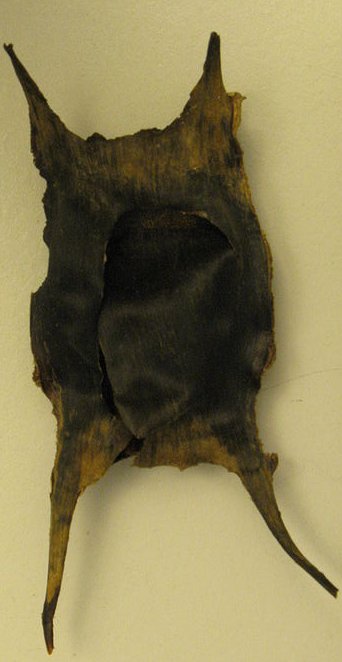
|
 |
 |
 |
|
ika hiku |
Ga7-12 (181) |
Ga7-27
(*116) |
Hiku. Tail;
caudal fin.
Hikukio'e,
'rat's tail': a
plant (Cyperus
vegetus).
Vanaga.
...
In the deep night
before the image [of
Lono] is
first seen, there is
a Makahiki
ceremony called
'splashing-water' (hi'uwai). Kepelino
tells of sacred
chiefs being carried
to the water where
the people in their
finery are bathing;
in the excitement
created by the
beauty of their
attire, 'one person
was attracted to
another, and the
result', says this
convert to
Catholicism, 'was by
no means good'
...
|
And then we also ought to remember
from the B text, where the missing
limb was at the right (back) side of the
torso:
|
Kua oho ki te nuku
honu |
mai tae huri ïa |
ki te motomotou honu |
 |
 |
 |
|
Ba8-1 (10 * 29½) |
Ba8-2 (296 = 175 + 11 *
11) |
Ba8-3 (181 + 4 * 29 =
297) |
|
Dec 11 (345) |
12 |
LUCIA |
|
Al Shaula-17
ALWAID (Mother Camels) =
β
Draconis, MAASYM (Wrist)
=
λ
Herculis
(265.1),
SHAULA
(Sting) =
λ
Scorpii
(265.3),
KUMA =
ν
Draconis
(265.6),
σ
Arae (265.9)
HAMAL (α ARIETIS) |
RAS ALHAGUE
= α Ophiuchi
(266.1),
SARGAS = θ Scorpii (266.3),
μ Ophiuchi, π Arae
(266.5),
NAN HAE (Southern Sea) =
ξ Serpentis
(266.6), AL
DHĪLI
(The Wolf) = ω Draconis,
ι Herculis (266.7) |
λ
Arae (267.1),
GIRTAB
(Seizer) =
κ
Scorpii,
ο
Serpentis (267.6),
DSIBAN
(Wolf Pair) =
ψ
Draconis
(267.9) |
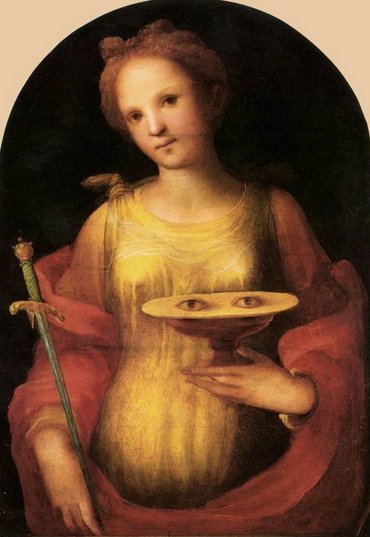 |
|
no glyph
|
 |
28
|
 |
235
|
 |
 |
 |
|
Ba1-1 |
Ba1-30 |
Ba8-1 (10 * 29½) |
Ba8-2 (30 + 236) |
Ba8-3 (181 + 4 * 29 =
297) |
|
March 21 (80) |
22 |
April 20 (110) |
Dec 11 (345) |
Dec 12 |
LUCIA |
|
SIRRAH (0h) |
ALGENIB PEGASI |
HAMAL (*30) |
ALWAID |
RAS ALHAGUE (*266) |
DSIBAN
|
|
 |
 |
4 |
 |
 |
|
Ga7-27 |
Ga7-28 |
Dec 12 |
LUCIA |
|
RAS ALGETHI (*260) |
δ Herculis |
RAS ALHAGUE (*266) |
ψ Draconis |

|
Egyptian flail |
 |
Phoenician lamed |
 |
Greek
psi |
Ψ (ψ) |
|
Wikipedia: In
writing, the early
letter appears in an
angular shape ( ).
There were early
graphical variants
that omitted the
stem,
'chickenfoot-shaped
psi', as: ).
There were early
graphical variants
that omitted the
stem,
'chickenfoot-shaped
psi', as:
 or
or

In
later research it
was postulated that
the [Phoenician]
alphabet is actually
two complete lists,
the first dealing
with land
agriculture and
activity, and the
second dealing with
water, sea and
fishing.
The first half
beginning with
Alef - an ox,
and ending with
Lamed - a whip.
The second list
begins with Mem
- water, and
continues with
Nun - fish,
Samek - fish
bones, Ayin -
a water spring,
Peh - the mouth
of a well, Tsadi
- to fish, Kof,
Resh and
Shin are the
hook hole, hook head
and hook teeth,
known to exist from
prehistoric times,
and the Tav
is the mark used to
count the fish
caught.
The Crook and Flail
were instruments of
the Pharaoh:
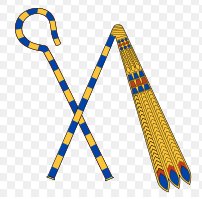 |
7 blue +
6 yellow (in the Flail) + (7
+ 5) blue + (6 + 6) yellow
(in the Crook) = 19 blue +
18 yellow = 37 = 13 (Flail)
+ 24 (Crook).
Counting
also the 3 extra
multicoloured ones for
flogging with the flail, the
sum becomes 40.
... The
cross formed by the Flail
... and the Crook ... are
probably illustrating the
pair of growth halfyears -
acceleration in spring
(early) respectively slowing
down in autumn (late)
... At
the beginning of 44 B.C. -
when Ceasar was still alive
- the Senate decided to
raise statues of him in all
the temples and to sacrifice
to him on his birthday in
the month Quintilis,
which in honour of him was
renamed July. He was raised
to the status of a god
(among the other gods of the
state) under the name
Jupiter Julius. Marcus
Antonius, who this year was
consul together with Ceasar,
became high priest and
responsible for the
ceremonies. In the middle of
February, at the time of the
old feast of Lupercalia, he
ran around ... and whipped
the Roman ladies with thongs
made from goat-skin, in
order to promote ... their
fertility ...
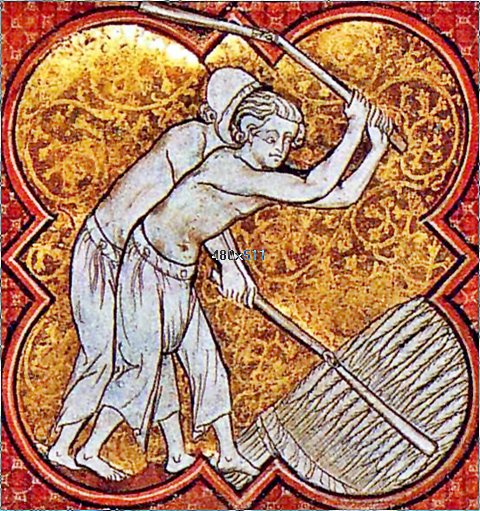
|












